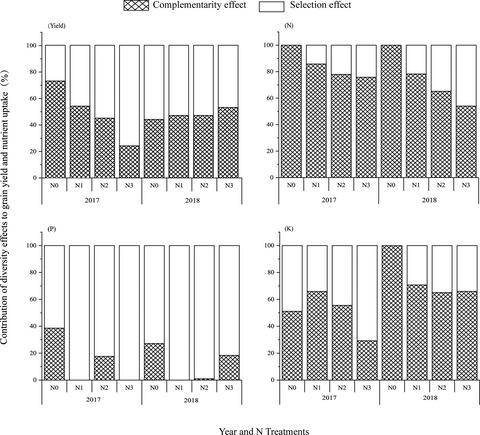当前位置:
X-MOL 学术
›
Food Energy Secur.
›
论文详情
Our official English website, www.x-mol.net, welcomes your feedback! (Note: you will need to create a separate account there.)
Yield and nutrient uptake dissected through complementarity and selection effects in the maize/soybean intercropping
Food and Energy Security ( IF 5 ) Pub Date : 2021-03-21 , DOI: 10.1002/fes3.282 Runzhi Zhang 1 , Lingbo Meng 2 , Ying Li 1 , Xuerong Wang 1 , Abiola O. Ogundeji 1 , Xinrui Li 1 , Ping Sang 1 , Yao Mu 1 , Haolei Wu 1 , Shumin Li 1
Food and Energy Security ( IF 5 ) Pub Date : 2021-03-21 , DOI: 10.1002/fes3.282 Runzhi Zhang 1 , Lingbo Meng 2 , Ying Li 1 , Xuerong Wang 1 , Abiola O. Ogundeji 1 , Xinrui Li 1 , Ping Sang 1 , Yao Mu 1 , Haolei Wu 1 , Shumin Li 1
Affiliation

|
The yield and nutrient uptake advantages in an intercropping system are commonly supposed to be driven by the overall functional complementarity and temporal/space niche differentiation between the species. However, studies on the separation of the complementarity effect (CE) and selection effect (SE) on yield and nutrient uptake to understand the underlying mechanisms of intercropping mediated by N application rates are relatively few. Here, field experiments with four N application rates (maize: 0, 180, 240, and 300 kg N ha−1; soybean: 0, 40, 80, and 120 kg N ha−1) were conducted to study yield and nutrient uptake advantages in the maize/soybean intercropping system in 2017 and 2018. Intercropping significantly enhanced the maize yield and decreased the soybean yield, and yield advantage was observed across all N application rates. Also, the gross profit was significantly affected by N application rates and intercropping, and the maximum increase in intercropped compared to that of monoculture appeared at the N2 treatment in 2018. Moreover, nutrient uptake was significantly affected by intercropping and N application rates; the N uptake of the intercropping system (on average of two years) was highest at the N2 application rate, which increased by 13.8% compared to that of monoculture system. CE and SE of grain yield were positive over the two‐year study and were both the main contributions. Furthermore, SE in N and P (only observed in 2017) uptake increased with the increase in N application rate, and SE was the main contribution to P uptake. Application of the additive partitioning method to intercropping may help to analyze the drivers of yield and nutrient advantage of intercropping and promote careful management of fertilizer application to improve nutrient use efficiency.
中文翻译:

通过玉米/大豆间作的互补和选择效应剖析产量和养分吸收
间作系统中的产量和养分吸收优势通常被认为是由物种之间的整体功能互补性和时空生态位分化驱动的。然而,关于互补效应(CE)和选择效应(SE)对产量和养分吸收的分离的研究,以了解由氮肥施用量介导的间作的潜在机理的研究相对较少。在此,以四个氮肥施用量(玉米:0、180、240和300 kg N ha -1;大豆:0、40、80和120 kg N ha -1)进行田间试验。)进行了研究,研究了2017年和2018年玉米/大豆间作系统的产量和养分吸收优势。间作显着提高了玉米产量并降低了大豆产量,并且在所有氮肥施用量下均观察到了产量优势。另外,氮肥施用量和间作对毛利润有显着影响,与单作相比,间作作物的最大增幅出现在2018年的N2处理中。此外,间作和氮肥施用量对养分吸收有显着影响。间作系统中的氮素吸收量(平均两年)在氮素施用量最高的情况下最高,与单一栽培系统相比增加了13.8%。在为期两年的研究中,谷物单产的CE和SE均呈阳性,并且都是主要贡献。此外,氮和磷的SE吸收(仅在2017年观察到)随着氮肥施用量的增加而增加,而SE是促进P吸收的主要因素。间作中添加分配法的应用可能有助于分析间作的产量和养分优势的驱动因素,并促进对肥料施用的谨慎管理,以提高养分利用效率。
更新日期:2021-05-12
中文翻译:

通过玉米/大豆间作的互补和选择效应剖析产量和养分吸收
间作系统中的产量和养分吸收优势通常被认为是由物种之间的整体功能互补性和时空生态位分化驱动的。然而,关于互补效应(CE)和选择效应(SE)对产量和养分吸收的分离的研究,以了解由氮肥施用量介导的间作的潜在机理的研究相对较少。在此,以四个氮肥施用量(玉米:0、180、240和300 kg N ha -1;大豆:0、40、80和120 kg N ha -1)进行田间试验。)进行了研究,研究了2017年和2018年玉米/大豆间作系统的产量和养分吸收优势。间作显着提高了玉米产量并降低了大豆产量,并且在所有氮肥施用量下均观察到了产量优势。另外,氮肥施用量和间作对毛利润有显着影响,与单作相比,间作作物的最大增幅出现在2018年的N2处理中。此外,间作和氮肥施用量对养分吸收有显着影响。间作系统中的氮素吸收量(平均两年)在氮素施用量最高的情况下最高,与单一栽培系统相比增加了13.8%。在为期两年的研究中,谷物单产的CE和SE均呈阳性,并且都是主要贡献。此外,氮和磷的SE吸收(仅在2017年观察到)随着氮肥施用量的增加而增加,而SE是促进P吸收的主要因素。间作中添加分配法的应用可能有助于分析间作的产量和养分优势的驱动因素,并促进对肥料施用的谨慎管理,以提高养分利用效率。


























 京公网安备 11010802027423号
京公网安备 11010802027423号